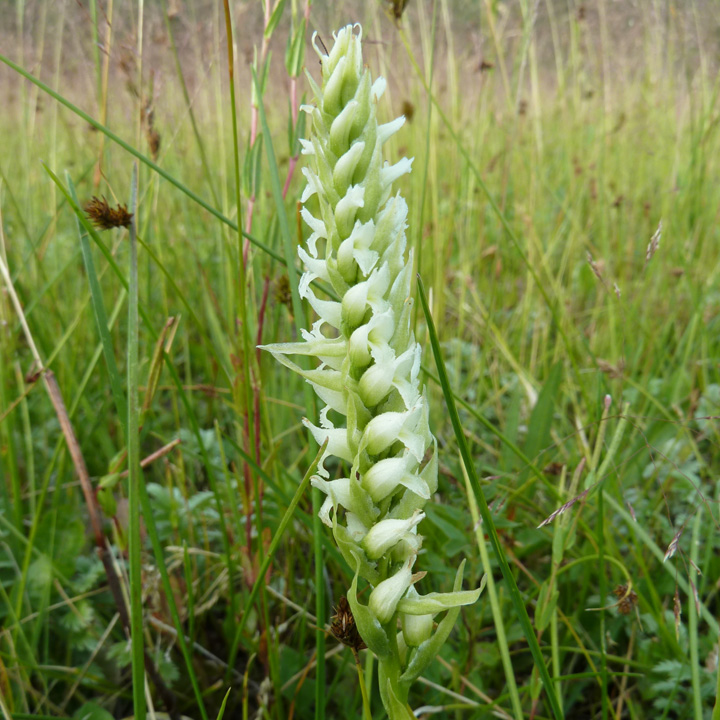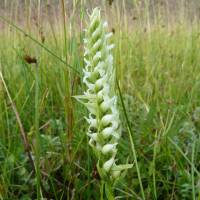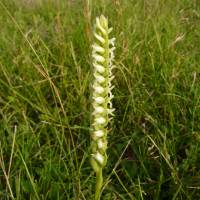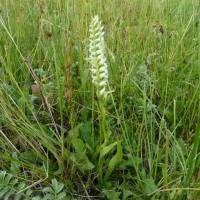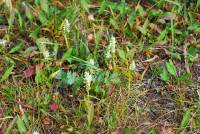Plants 8-55 cm. Roots few-several, spreading to descending, tuberous, mostly to 1 cm diam. Leaves persisting through anthesis or fugaceous, basal, often on proximal portion of stem, ascending to spreading, linear to linear-lanceolate, elliptic, or oblanceolate, to 26 × 3 cm. Spikes usually very tightly spiraled, 3 flowers per cycle of spiral, rarely loosely spiraled or with more than 5 flowers per cycle; rachis glabrous to very sparsely pubescent, capitate glands short-stalked or often sessile (longest trichomes 0.03-0.18 mm). Flowers ascending, white to ivory, rarely yellowish white, tubular; sepals and petals connivent, forming hood above abruptly reflexed lip; sepals connate at base, 5.3-12.5 mm; petals linear to ovate, apex obtuse to subacute; lip pandurate, 4.8-10.2 × 1.6-6.8 mm, base broadly expanded, apex broadly dilated, separated by narrow isthmus, apical dilation variable, rarely lip nearly ovate, glabrous or with a few scattered trichomes on adaxial surface; veins typically 3, branches wide-spreading; viscidia linear-lanceolate; ovary 2-7 mm. Seeds monoembryonic. 2n = 44, 66, 88.
Flowering Jun--Sep(--Oct). Moist to wet meadows, tundra, marshes, fens, prairies, stream banks, seeps, coastal bluffs, dunes; 0--3400 m; Alta., B.C., Man., N.B., Nfld. and Labr. (Nfld.), N.W.T., N.S., Nunavut, Ont., P.E.I., Que., Sask., Yukon; Alaska, Ariz., Calif., Colo., Conn., Idaho, Ill., Ind., Iowa, Maine, Mass., Mich., Minn., Mont., Nebr., Nev., N.H., N.Mex., N.Y., N.Dak., Oreg., Pa., S.Dak., Utah, Vt., Wash., Wis., Wyo.; Europe (Great Britain, n Ireland).
Plants of Spiranthes romanzoffiana vary considerably in habit but are usually quite consistent in floral morphology. The strongly hooded, ascending flowers with abruptly reflexed lips provide a distinctive geometric precision. The pandurate lip with typically three veins, the lateral with abruptly wide-spreading branches, is a key feature. In some areas, however, especially at the edges of the range of the species, some variation is apparent and is sometimes coincident with variability in ploidy level. In particular, in California and adjacent southwestern Oregon variability reaches its peak, with plants variously exhibiting yellowish flowers, loosely spiraled inflorescences, and spreading lateral sepals. Some of this variation may result from gene flow from S. porrifolia, but with various ploidy levels common in this area, even within populations, the situation is apparently more complex than simple hybridization.
Hybrids of Spiranthes romanzoffiana with S. lacera var. lacera are known as S. × simpsonii Catling & Sheviak.
Perennial herb 8 - 55 cm tall
Stem: single, erect, green, usually only with sheaths most of length.
Leaves: several, basal and on lowest part of stem, ascending to spreading, hairless, non-toothed, very long (up to 26 cm long), 0.5 - 1.5 cm wide, linear to more lance-shaped or elliptic. The leaves usually persist through flowering time.
Inflorescence: a single, erect, terminal, elongate, tight spike of numerous, ascending, stalkless flowers. The flowers are arranged in a very tight, somewhat angular, almost three-ranked spiral with three flowers per full turn around the axis (rarely loosely spiraled or with more than five flowers per cycle). Axis usually hairless, but sometimes with hairs and short-stalked glandular hairs.
Flowers: white to ivory (rarely yellowish white), bilaterally symmetric, around 1 cm long (above ovary), tubular with sepals and petals forming hood above deflexed lip. The reproductive parts of stamens, stigma and style are fused into a column above the 2 - 7 mm long inferior ovary.
Sepals: three (but fused at base), petal-like, whitish, 0.5 - 1.25 cm long, fairly linear with pointed tips, forward-pointing and closely positioned with lateral petals to form hood over lip.
Roots: few to several, spreading to descending, tuberous (up to 1 cm diameter).
Lateral petals: two, forward-pointing, closely positioned with sepals forming hood over lip, white, 0.6 - 1.25 cm long, linear to narrowly egg-shaped with tapered tips.
Lip petal: one, central, lowermost, abruptly deflexed, whitish to creamy, hairless or with few scattered hairs, 4.8 - 1 cm long, 1.6 - 6.8 mm wide, fiddle-shaped with distinct narrowing near middle, then flaring toward ruffle-edged tip. There are usually three, widely spreading vein branches along the lip, and only minute (under 1 mm), basal projections (calli).
Similar species: Spiranthes romanzoffiana is quite unique among our regional species of ladies' tresses due to the tightly positioned sepals and petals forming a tubular hood above the deflexed lip, the lip is distinctive in being fiddle-shaped (wide at base, obviously narrowed near middle, flaring to tip), and further the often hairless inflorescence with ascending flowers may appear three-angled due to the tight arrangement of flowers in almost three ranks.
Flowering: August
Habitat and ecology: Very rare, in low sandy prairies, moist or wet meadows, fens, seeps, and even on floating bog mats.
Occurence in the Chicago region: native
Notes: This is a much more northern plant, and the Chicago Region lies at the most southern edge of its range in eastern North America. A very rare orchid in our area to begin with, at least one site (in Porter Co., IN) where it was known to occur has been destroyed.
Author: The Field Museum
General: Perennial, 8-55 cm tall; stems stout, glabrous below, somewhat glandular-pubescent above, or sometimes glabrous throughout; roots few to several, tuberous.
Leaves: Basal and lower cauline, alternate, linear to linear- lanceolate, 5-10 cm long, 0.5-1.2 cm wide, abruptly reduced above to sheathing bracts, glabrous, margins entire.
Flowers: Inflorescence a spike-like raceme, 6-22 cm long, the rachis thick, densely flowered; bracts subtending the flowers inconspicuous, triangular to lanceolate, 0.5-1 mm long; flowers 40-160, nearly sessile (pedicels 1.3-1.7 mm long), not resupinate, green to yellowish green; upper and lateral sepals ovate to elliptic 1.5-2.8 mm long, the lateral ones hooked; petals strongly reflexed, filiform to linear, hooked, 1.3-2 mm long; lip sub-orbiculate to ovate, 3-toothed at the apex, the center tooth smallest; flowers July-September.
Fruits: Capsule, ellipsoid to ovoid, 1 cm long, pubescent.
Ecology: Mountain meadows, along streams and roadside ditches, usually in full sun and moist to wet soils; 2250-3350 m (7400-11000 ft); Apache, Coconino, and Graham counties; Canada, northeastern, northwestern to southwestern U.S.
Notes: Platanthera sparsiflora (canyon habenaria) [=Habenaria sparsiflora] is an erect perennial, 10-65 cm tall; with several sheathing leaves clustered along the base of the stem, narrowly lanceolate or lanceolate, 6.5-30 cm long; inflorescence is a spike with greenish flowers, these resupinate; lateral sepals reflexed to spreading, upper sepal converging with the petals to form a hood; lip is pendent and spurred at the base, the spur as long as or longer than the lip; capsule is ellipsoid to cylindric. It occurs in meadows, mountain springs or seeps, and other wet habitats at 2100-2700 m (7000-9000 ft) in Apache, Coconino, and Navajo counties. Platanthera hyperborea (northern green habenaria) [=Habenaria hyperborea] is similar, but is distinguished by leaves scattered along the stem; the spur being shorter than the lip, this club-shaped, yellowish green; flowers are sweet-scented. It occurs in similar habitats but has only been reported for Apache County. Platanthera purpurascens (purple-petal bogorchid) [=P. hyperborea var. purpurascens] is distinguished by having a saccate spur, this strongly club-shaped; the lip is yellowish green to bluish green; flowers are strongly musty-scented. It occurs on slopes, roadsides, streambanks, thickets, and open woods. Epipactis gigantea (stream orchid, giant helleborine) only occasionally reaches our elevational range. Plants are generally tall, reaching 140 cm, leafy- stemmed; leaves are ovate to narrowly lanceolate, 5-20 cm long, 2-7 cm wide; racemes are lax, bearing 2-32 showy flowers; sepals are 12-18 mm long, greenish to rose colored with purplish veins; petals are 13-17 mm long, pink to orange with red or purple veins, the lip 3-lobed, strongly veined, the veins dark purple. It occurs in seeps, springs, streambanks, hanging gardens, and other wet habitats.
Editor: Springer et al. 2008
Plants 1-4 dm; basal lvs narrow, up to 20(-25) cm, 5-15 mm wide; cauline sheaths 3-5, the uppermost ±bladeless; spikes 3-10 cm, dense (especially above), the fls in 3 or 4 vertical ranks, individually up- and outcurved, white or ochroleucous to chloroleucous; sep basally connate, rather prominently veined, sparsely viscid-hairy, connivent with the lateral pet to form an open-tubular hood 7-12 mm, the lateral sep often with reflexed tip; lip sharply deflexed, about as long as the sep, pandurate with an expanded, erose tip, with prominent divergent veins below the constriction, generally only the midvein continued beyond; basal callosities of the lip inconspicuous, under 1 mm; viscidium 1.3-2 mm; 2n=(30)44(60). Swamps, bogs, and wet shores; Nf. and Lab. to Alas., s. to N.Y., n. Pa., n. O., Mich., Io., Nebr., and Calif.; Ireland. July-Sept. (S. stricta)
Gleason, Henry A. & Cronquist, Arthur J. 1991. Manual of vascular plants of northeastern United States and adjacent Canada. lxxv + 910 pp.
©The New York Botanical Garden. All rights reserved. Used by permission.


